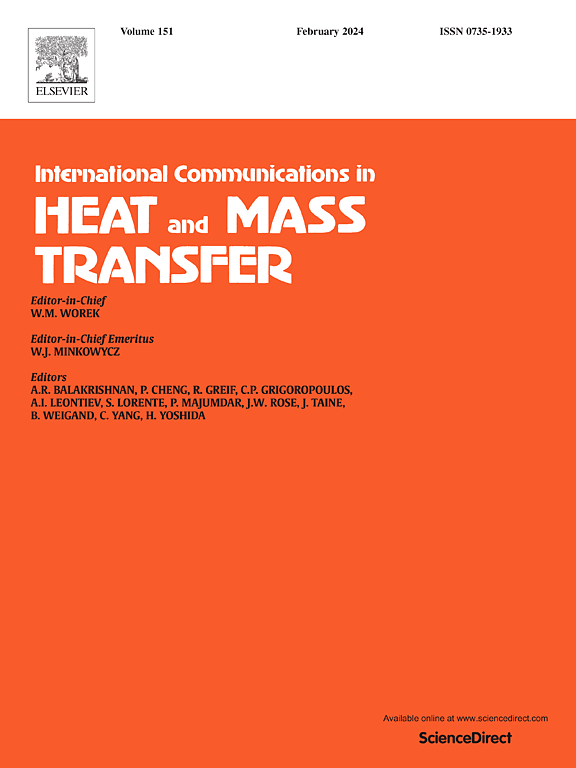基于数值模拟和模型预测的扭曲椭圆管壳式换热器流动传热特性分析与优化
IF 6.4
2区 工程技术
Q1 MECHANICS
International Communications in Heat and Mass Transfer
Pub Date : 2025-05-14
DOI:10.1016/j.icheatmasstransfer.2025.109077
引用次数: 0
摘要
传统的管壳式换热器在提高热效率方面存在很大的局限性。为了解决这个问题,提出了一种新的壳管式换热器设计,采用扭曲的椭圆形管代替传统的圆管。本文研究了扭距长度和壳侧雷诺数对带折流板的扭椭圆管壳管换热器传热和流动特性的影响。采用二次多项式模型和人工神经网络模型对输入变量进行优化。结果表明:与带折流板的圆形管壳式换热器相比,带折流板的扭曲椭圆形管壳式换热器换热系数提高了15.9%,压降降低了28.9%;换热系数随扭距长度的增加而减小,当扭距长度从60 mm增加到90 mm时,换热系数降低幅度最大,为5.7%。反之,随着雷诺数的增加,换热系数明显增大。压降随雷诺数的增加而显著增大,但随扭距长度的增加而减小。换热系数与压降之比随雷诺数的增加而减小,但减小幅度较小,而扭节长度对换热系数与压降之比的影响不如雷诺数明显。当扭节长度为60 mm,雷诺数从3167增加到5588时,换热系数与压降之比从1.61减小到0.46 W/m2·K·Pa,减小幅度最大。扭节长度和雷诺数的相互作用对换热系数和压降有显著影响。两种预测模型均具有较高的准确性,其中人工神经网络模型优于二次多项式模型,特别是在预测压降方面。人工神经网络和二次多项式模型对换热系数的敏感性也高于对压降的敏感性,对压降的预测精度差异更明显。本文章由计算机程序翻译,如有差异,请以英文原文为准。
Analysis and optimization on flow and heat transfer characteristics of twisted oval shell-and-tube heat exchangers based on numerical simulation and model prediction
Conventional shell-and-tube heat exchangers face substantial limitations in improving thermal efficiency. To address this, a novel shell-and-tube heat exchanger design incorporating twisted oval tubes in place of conventional round tubes is proposed. This study examines the effects of twisted pitch length and shell-side Reynolds number on the heat transfer and flow characteristics of the twisted oval tube shell-and-tube heat exchanger with baffles. The optimization of input variables was performed using a quadratic polynomial model and an artificial neural network model. The findings demonstrate that compared to the round shell-and-tube heat exchanger with baffles, the heat transfer coefficient of the twisted oval shell-and-tube heat exchanger with baffle increases by 15.9 % and the pressure drop decreases by 28.9 %. The heat transfer coefficient decreases with increasing twisted pitch length, with the most significant reduction of 5.7 % observed as twisted pitch length increased from 60 mm to 90 mm. Conversely, the heat transfer coefficient increases markedly with higher Reynolds number. The pressure drop rises substantially with increasing Reynolds number but decreases with higher twisted pitch length. The ratio of heat transfer coefficient to pressure drop declines with increasing Reynolds number, albeit at a diminishing rate, while the influence of twisted pitch length on the ratio of heat transfer coefficient to pressure drop is less pronounced compared to Reynolds number. When the twisted pitch length was 60 mm and the Reynolds number increased from 3167 to 5588, the ratio of heat transfer coefficient to pressure drop decreased from 1.61 to 0.46 W/m2·K·Pa, representing the maximum decline. The interactions between twisted pitch length and Reynolds number significantly affect heat transfer coefficient and pressure drop. Both predictive models demonstrate high accuracy, with the artificial neural network model outperforming the quadratic polynomial model, particularly in predicting pressure drop. The artificial neural network and quadratic polynomial models also exhibit greater sensitivity to heat transfer coefficient than to pressure drop, with discrepancies in predictive accuracy being more evident for pressure drop.
求助全文
通过发布文献求助,成功后即可免费获取论文全文。
去求助
来源期刊
CiteScore
11.00
自引率
10.00%
发文量
648
审稿时长
32 days
期刊介绍:
International Communications in Heat and Mass Transfer serves as a world forum for the rapid dissemination of new ideas, new measurement techniques, preliminary findings of ongoing investigations, discussions, and criticisms in the field of heat and mass transfer. Two types of manuscript will be considered for publication: communications (short reports of new work or discussions of work which has already been published) and summaries (abstracts of reports, theses or manuscripts which are too long for publication in full). Together with its companion publication, International Journal of Heat and Mass Transfer, with which it shares the same Board of Editors, this journal is read by research workers and engineers throughout the world.

 求助内容:
求助内容: 应助结果提醒方式:
应助结果提醒方式:


